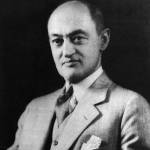[This lecture is Part 3 of the Entrepreneurship and Values series and was recorded at Rockford University and sponsored by the Center for Ethics and Entrepreneurship.]
Terry Noel on Management and Entrepreneurship
 Hello, my name is Terry Noel. I am an Associate Professor of Management and Quantitative Methods at Illinois State University. Today, we are going to talk about Management and Entrepreneurship.
Hello, my name is Terry Noel. I am an Associate Professor of Management and Quantitative Methods at Illinois State University. Today, we are going to talk about Management and Entrepreneurship.
First, let’s talk about Management. Management is usually thought of as having four main components: planning, organizing, leading, and controlling. Planning, of course, is deciding what we are going to do, organizing is getting together the resources that we need to accomplish our plans. Leading is getting other people to march with us toward the destination we’ve decided on in our planning and controlling is checking ourselves along the way to make sure that we are headed in the direction we need to head to accomplish what we are planning to accomplish.
Management as a discipline really didn’t emerge until a little over a hundred years ago. Now, this didn’t mean that people weren’t managing before then. It’s just that it was not really recognized as a formal discipline. For instance, in the Old Testament, we have a story of Moses, who was asked to decide legal disputes within the tribes of Israel. Now, you can imagine there were twelve tribes of Israel and Moses probably had a pretty full schedule trying to decide all of the disputes that people had. It finally became too overwhelming. So, Moses brought together the leaders of the 12 tribes and assigned power and authority to each one of the leaders within the tribes. Now the idea was that each tribe leader would make his own decisions about the justice of disputes and then, if he couldn’t resolve it, he would appeal to Moses. This is really one of the first examples we have of formal delegation.
 Ancient Rome is another good example of a management thought. The ancient Romans had a very large empire to manage, the largest up to that time in history. Now how do you take care of an empire that stretches from the Middle East all the way up to the shores of England? Well, we have to have some type of system of communication, so the ancient Romans developed a set of roads and a system of ways to travel, so that they could govern this large empire. Like Moses, they found that central authority was overwhelmed with decision-making, so they established a system of governors, who would each manage a geographic area and then large decisions were bumped upward to the Caesar or the Senate.
Ancient Rome is another good example of a management thought. The ancient Romans had a very large empire to manage, the largest up to that time in history. Now how do you take care of an empire that stretches from the Middle East all the way up to the shores of England? Well, we have to have some type of system of communication, so the ancient Romans developed a set of roads and a system of ways to travel, so that they could govern this large empire. Like Moses, they found that central authority was overwhelmed with decision-making, so they established a system of governors, who would each manage a geographic area and then large decisions were bumped upward to the Caesar or the Senate.
The Chinese also developed some management techniques and, at the time that war was engaged in, even in an early part of the Common Era, starting with the birth of Christ, there were large wars that transcended the tribal warfare that we had seen up to this time. And one can imagine, between all the horses, and all of the people with weapons, spread out over a large geographic area, it’s very hard to coordinate the activities of soldiers in that large an area in the real time of battle. Well, the Chinese developed a set of flags, gongs and signal fires which would allow them to coordinate attacks and defensive maneuvers centrally, but without having to stand and shout to people within earshot about what to do.
 Now even though there were these management techniques that had evolved over the years, there really wasn’t much of a formal disciplined look at the study of management until about the founding of the United States. Roughly the time of Adam Smith. Adam Smith is not usually considered a management theorist as such, but in addition to his work on free markets and economics, he also did a study of the division of labor. What Adam Smith found was that pin workers who were basically taking wire and making pins for use in sewing, and each person would take a section of wire and make a pin. Now we can imagine that this would take a tremendous amount of time. And there were several stages in the process. Adam Smith noted that if each person were only to do a very specific subtask, that they could produce many, many over the number of pins with the same amount of labor. So Adam Smith had really discovered efficiencies of scale.
Now even though there were these management techniques that had evolved over the years, there really wasn’t much of a formal disciplined look at the study of management until about the founding of the United States. Roughly the time of Adam Smith. Adam Smith is not usually considered a management theorist as such, but in addition to his work on free markets and economics, he also did a study of the division of labor. What Adam Smith found was that pin workers who were basically taking wire and making pins for use in sewing, and each person would take a section of wire and make a pin. Now we can imagine that this would take a tremendous amount of time. And there were several stages in the process. Adam Smith noted that if each person were only to do a very specific subtask, that they could produce many, many over the number of pins with the same amount of labor. So Adam Smith had really discovered efficiencies of scale.
 In addition to Adam Smith, other thinkers at the time include Eli Whitney. Eli Whitney is often associated with the cotton gin, but what most people don’t realize is that Whitney actually went bankrupt trying to sell the cotton gin. The problem was he couldn’t protect his patents and so many knock-offs around the south at that time put him out of business. The part of Eli Whitney’s history that most people don’t know is that he developed interchangeable parts. Whitney, never having manufactured a gun at all in a factory, went to Congress with a proposal. And he said that I have a way of manufacturing guns, which not only is cheaper and more reliable, but solves a tremendous problem on the battlefield. At the time, muskets were made, but they were uniquely built according to the whims of each particular gunsmith. So, basically, the technology was the same. We might have something like the flintlock rifle or a musket, a cap-and-ball musket, but they all worked basically the same way, but had their idiosyncrasies. So the hammer, for instance, on one gun, would not fit on another gun. The trigger on one gun, would not fit on another gun. And since everything was made differently, it was quite inconvenient in battle to have your gun break. Because, unless you just happened to carry some spare parts unique to that gun, you were out of luck. What Whitney showed was that by making all the parts the same, that could keep stockpile of parts for emergency use in battle. The most impressive part of the story is how Whitney sold the idea to Congress of interchangeable parts. As the story goes, he made his presentation with a long table, and the table had piles of parts. While talking to Congress, Whitney started in one side of the table and kept talking as he put together a musket and laid it down, went back to the beginning of the table and did the same thing until while, in the course of his presentation, he had assembled, all while talking, a pile of ten muskets. Congress was so impressed they awarded him a contract, even though he had never had any experience in factories building weapons of this kind.
In addition to Adam Smith, other thinkers at the time include Eli Whitney. Eli Whitney is often associated with the cotton gin, but what most people don’t realize is that Whitney actually went bankrupt trying to sell the cotton gin. The problem was he couldn’t protect his patents and so many knock-offs around the south at that time put him out of business. The part of Eli Whitney’s history that most people don’t know is that he developed interchangeable parts. Whitney, never having manufactured a gun at all in a factory, went to Congress with a proposal. And he said that I have a way of manufacturing guns, which not only is cheaper and more reliable, but solves a tremendous problem on the battlefield. At the time, muskets were made, but they were uniquely built according to the whims of each particular gunsmith. So, basically, the technology was the same. We might have something like the flintlock rifle or a musket, a cap-and-ball musket, but they all worked basically the same way, but had their idiosyncrasies. So the hammer, for instance, on one gun, would not fit on another gun. The trigger on one gun, would not fit on another gun. And since everything was made differently, it was quite inconvenient in battle to have your gun break. Because, unless you just happened to carry some spare parts unique to that gun, you were out of luck. What Whitney showed was that by making all the parts the same, that could keep stockpile of parts for emergency use in battle. The most impressive part of the story is how Whitney sold the idea to Congress of interchangeable parts. As the story goes, he made his presentation with a long table, and the table had piles of parts. While talking to Congress, Whitney started in one side of the table and kept talking as he put together a musket and laid it down, went back to the beginning of the table and did the same thing until while, in the course of his presentation, he had assembled, all while talking, a pile of ten muskets. Congress was so impressed they awarded him a contract, even though he had never had any experience in factories building weapons of this kind.
Now these have to do with what we now call operations management. And this is the look at how things are made and how to make them more efficiently and more cost effectively. Roughly a hundred years later, about the turn of the 20th century, we start to see people thinking systematically about how to manage things better. One of the first things we did were, we took a look at time and motion. People like the Gilbreths, Frank and Lillian, used newly invented video cameras and meticulous documenting to figure out the one best way to do physical work. It turns out that the work of Frank and Lillian led to vast improvements and efficiencies. Likewise with Frederick Taylor, who used methods of efficiency to make the shoveling of different materials highly efficient by using a different shovel for each type of material, based on the most efficient weight for a man to shovel.
Now, these things seem mundane to us, but at the time, these were radical insights into the way things were made and the way to improve manufacturing processes. What it also did has Taylor and Gilbreths really started prompting people to take a scientific look at management. How things work in organizations, and after this time, management theorists started thinking not just about the manufacturing characteristics that made business work well, but characteristics of the people within organizations as well. We started to get insights about how people relate, how people are incentivized, things that make people satisfied in organizations, the things that make people want to stay with or leave an organization.
And then, as we reach the 80s and the 90s, recently, we also started to take a little broader look at what is now called strategic management. Strategic management led by such thinkers as Michael Porter and Jay Barney takes a look at the company in the context of an industry and an economy and ask the question: what is the best way for this particular business and this particular industry to compete? Entrepreneurship involves management and in general it’s often said that good entrepreneurs make poor managers. I wouldn’t say that it is universally true, but we can understand how one can draw that type of conclusion. Because entrepreneurship as opposed to being planning, organizing, leading and controlling — kind of a preset set of objectives and tactics and strategies for achieving those objectives, entrepreneurship is more wild, is more wooly, and it’s usually characterized by acting on an opportunity that other people don’t see and don’t act upon. So an entrepreneur has to be comfortable in an environment in which the opportunities to create value and make a profit may not be recognized by the general public. Sometimes, entrepreneurs are even ahead of their customers, as was the case when Steve Jobs invented the computer before anyone realized just how indispensable they were to everyday life.
Entrepreneurship is usually characterized by disruption. It’s disruptive to the founder, as any entrepreneur will tell you: their lives are usually topsy-turvy, especially their early startup phase of their companies. Usually entrepreneurship is disruptive to an industry as well. For instance, having cellphones was very disruptive to the landline to telephony that existed up to that time. It changes things and stirs them up. It is also disruptive to the economy. However, we use the word disruptive very often we think of that as a negative thing. In reality, the change that characterizes economic process and economic progress is disruptive in the sense that old methods die out, old ideas die out, in favor of new things, new products, new services and new processes which help the general welfare of the public increase, and which helps entrepreneurs themselves, often become very wealthy by recognizing how to satisfy the needs and wants of the public.
Entrepreneurial thought is not nearly as old as management thought. In fact, scholars didn’t really start to address the issue of entrepreneurship until the 1990s. In fact, the first doctoral dissertation on the subject of entrepreneurship was at the 1970s, by Jeffry Timmons.  Timmons started people thinking about what the entrepreneurial process was and how it differed from big business and the management that, at that time, was taught almost universally in business schools. Effectively, business schools were training people for jobs in Fortune 500 companies, but, what happened as we near the 1990s, we started to see that the pace of change in technologies and cultural values had started accelerating. In fact, by the end of the 1990s, we started to see that most economic process or progress, rather, had come from small businesses. This includes job creation, and innovation. Especially really radical innovations. These were almost always coming from small businesses. We did have some people that had thought about entrepreneurship before Timmons, but they usually relegated to the pages of a management textbook. One was McClelland, who took a look at what he called “achieving societies,” and achieving societies in his mind were those in which a predominance of people had what he called a need for achievement. Those cultures’ societies would generally be better off when a significant portion of their members liked to achieve things. And we usually associate the desire for achievement with entrepreneurs.
Timmons started people thinking about what the entrepreneurial process was and how it differed from big business and the management that, at that time, was taught almost universally in business schools. Effectively, business schools were training people for jobs in Fortune 500 companies, but, what happened as we near the 1990s, we started to see that the pace of change in technologies and cultural values had started accelerating. In fact, by the end of the 1990s, we started to see that most economic process or progress, rather, had come from small businesses. This includes job creation, and innovation. Especially really radical innovations. These were almost always coming from small businesses. We did have some people that had thought about entrepreneurship before Timmons, but they usually relegated to the pages of a management textbook. One was McClelland, who took a look at what he called “achieving societies,” and achieving societies in his mind were those in which a predominance of people had what he called a need for achievement. Those cultures’ societies would generally be better off when a significant portion of their members liked to achieve things. And we usually associate the desire for achievement with entrepreneurs.
 The other thought on entrepreneurship came not from management theory so much, but from economists. For example, in the 1930s, Joseph Schumpeter thought that neoclassical economic models, which basically look at perfect competition, how we get what Schumpeter called an “evenly rotating” flow of goods and money in an economy get disrupted by entrepreneurs. Schumpeter saw this as an interesting problem, whereas for neoclassical economists, this had really been just a pain. It was very hard to fit the entrepreneur into economic models, because the entrepreneur does something new and disrupts things. This is very hard to model, and so it was kind of pushed to the side of economic thought until people like Schumpeter looked at it and decided that this was an interesting and important part of the economic process and, in fact, really is the driver behind any kind of economic process. So, the entrepreneur kind of gradually moved to the center stage in management thought. Other economists usually collectively known as the Austrian School of Economics asked similar questions. They were asking what is it that an entrepreneur does that disrupts the economy and how does that disruption lead to economic progress? From the Austrian School perspective, the important thing is the new idea, the thing that the entrepreneur does that is different that shakes things up and causes economies to grow and to change and for the people within those economies to prosper. Entrepreneurial thought since then has taken a number of directions.
The other thought on entrepreneurship came not from management theory so much, but from economists. For example, in the 1930s, Joseph Schumpeter thought that neoclassical economic models, which basically look at perfect competition, how we get what Schumpeter called an “evenly rotating” flow of goods and money in an economy get disrupted by entrepreneurs. Schumpeter saw this as an interesting problem, whereas for neoclassical economists, this had really been just a pain. It was very hard to fit the entrepreneur into economic models, because the entrepreneur does something new and disrupts things. This is very hard to model, and so it was kind of pushed to the side of economic thought until people like Schumpeter looked at it and decided that this was an interesting and important part of the economic process and, in fact, really is the driver behind any kind of economic process. So, the entrepreneur kind of gradually moved to the center stage in management thought. Other economists usually collectively known as the Austrian School of Economics asked similar questions. They were asking what is it that an entrepreneur does that disrupts the economy and how does that disruption lead to economic progress? From the Austrian School perspective, the important thing is the new idea, the thing that the entrepreneur does that is different that shakes things up and causes economies to grow and to change and for the people within those economies to prosper. Entrepreneurial thought since then has taken a number of directions.
At first, scholars emphasized the person, that is, our entrepreneur is different. But it turns out there is very little evidence to suggest that entrepreneurs are different from anybody else. Entrepreneurs in fact really can’t be distinguished from other people, who are not entrepreneurs, on the basis of personality characteristics. What is important is what an entrepreneur does. This was brought to light in the late 1980s by a scholar William Gartner. Bill Gartner pointed out that looking at who the entrepreneur is really the wrong question. What we need to ask ourselves is what an entrepreneur does. That has led us to looking at the process of entrepreneurship.
Now, there are a couple of interesting developments recently in entrepreneurship scholarship. One is the cognitive aspect. Do entrepreneurs really think differently? They may not have different personalities, but do they see the world differently? As it turns out, there is some research that suggest that this is the case. For example, we often think of entrepreneurs as risk takers. In reality, they don’t like any better than anybody else. What they do though is they perceive risk differently. An entrepreneur generally looks at a situation and assumes that he or she can solve the problem when they get to it. So, they don’t go seeking risk as much as they have a different slice at it than the rest of the population. We also have learned some stereotypes of entrepreneurs don’t pan out very well. For example, the idea of the lone wolf, the entrepreneur with the square jaw, the steely gaze and the white silk scarf blowing in the wind, going out on his or her own. In fact, most successful entrepreneurs are good at building teams. It’s very rare for a single individual to launch a new company. The idea may originate in the individual mind, but the execution usually requires multiple people with varying skills to make a solid team to have a successful launch. Management and entrepreneurship meet in a look at how societies and organizations function.
Transaction cost economics, for instance, seeks to explain why some companies are big, why some companies are little. Why do we have companies at all? As it turns out, large companies serve a very specific purpose. It’s hard to make one car economically, so we make millions of them at a time so that we get efficiencies of scale. However, large companies also have a drawback. They can become stodgy, bureaucratic, and not very responsive. So, the reason transaction economics is so valuable in explaining this is organizations are created because, when it’s cheaper to build something in your own organization, let’s say a raw material, is it better for me, for example, to make the tires that go on this car myself, or it better for me to farm that out to somebody else, and then put on the car that I am building? If it’s cheaper to build it in house, then this causes larger organizations, because now tire making and car making is under one roof. Now, in other types of businesses, being larger just gets in the way. Some people argue, for example, that banks have become too large for a variety of reasons. And if you ever tried to do business with a very, very big bank and you had a problem, you know what is like to go through seven or eight different people to get to the person that can finally, hopefully, give you an answer.
Why does this matter to us? Well, a couple of things I think are very, very important for us to remember as we look at training our people coming out of colleges now for the world of work they will face in the next three to five decades. One big event was the creation of the Internet. At first, it became commercially available in January in 1994. This has changed the world radically. Instead of having huge organizations, what we find now is that people can start up business just like this because they have access to information and resources that before were much too cumbersome and expensive to lay their hands on. So now we can see many, many opportunities arising not only from technology itself, but from non-technological businesses which are supported by technology. I think for the next few decades, this is going to mean we are going to see a world in which having a career with one organization for a number of years or a number of decades is going to become more and more rare. This rate of competition that we see is going to be tough, but it is also going to present a lot of opportunities for people to prosper.
I think in the future everyone will be a manager, we have to manage our resources, we have to manage other people if we have a job. And so, everyone will, to some degree, be involved in life as a manager. The real shift I think it’s going to be that the successful people will also be entrepreneurs. Now, this may mean starting one’s own business. But it can also mean just acting more entrepreneurially in the context of the organization you work for. And this means being able to think broadly, not just focusing on one functional area, like say accounting or marketing, but being able to have a broader picture of how your organization can create value in new and innovative ways. Companies right now are wrestling with the curse of bigness. And by bring entrepreneurial thinking into companies that already exist, I think the whole landscape of management thinking will start to change. We will start to see small sets of people, some say that we won’t have large organizations at all, but we will have small clusters of people who contract out with one another to accomplish things, but not under the umbrella of a larger organization. And for that reason, I think that at the intersection of management and entrepreneurship, we are going to see a distinct shift toward entrepreneurial thinking and entrepreneurial action. Not only on the part of individuals, but on the part of large and established companies.
[The video of this lecture by Terry Noel follows.]
